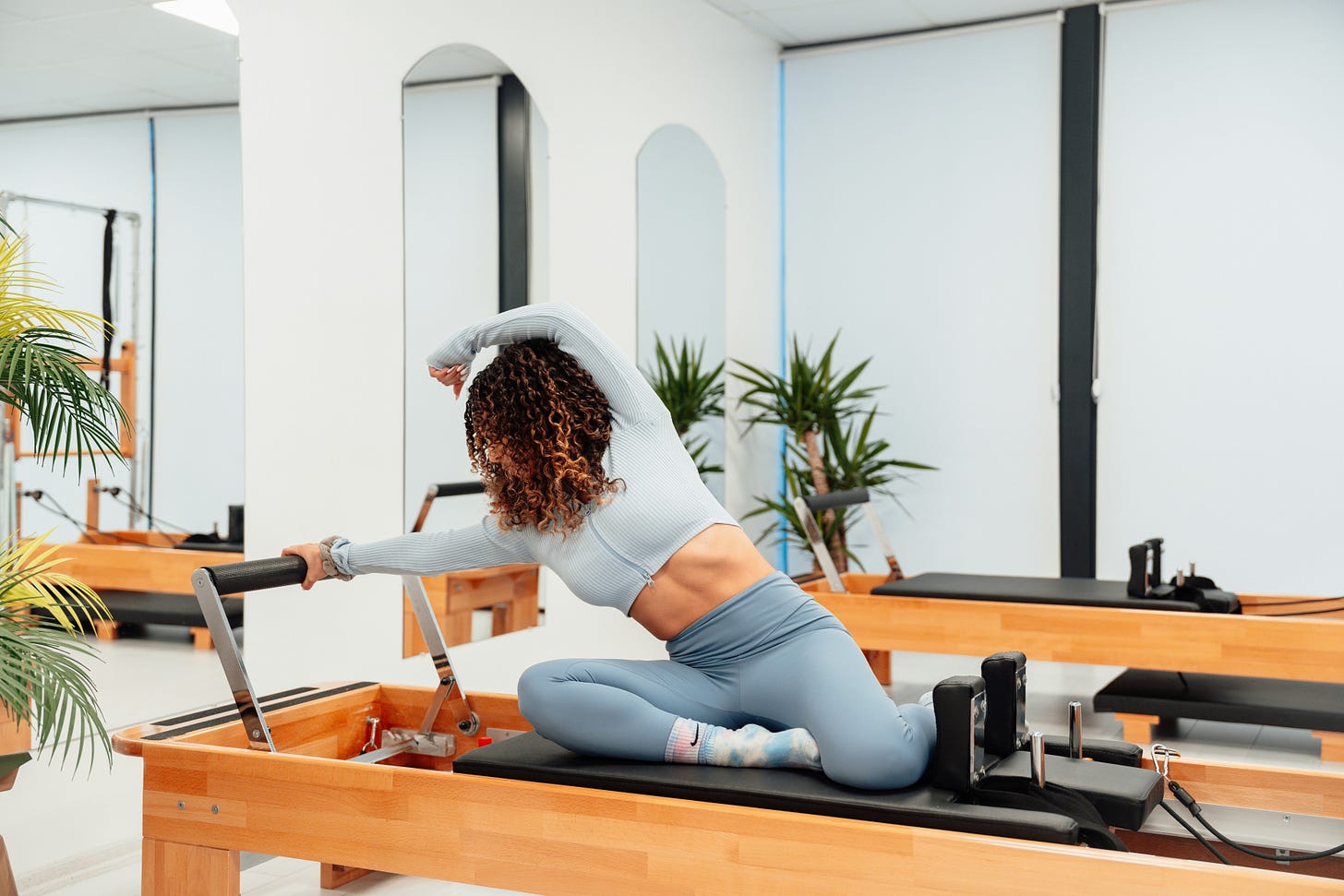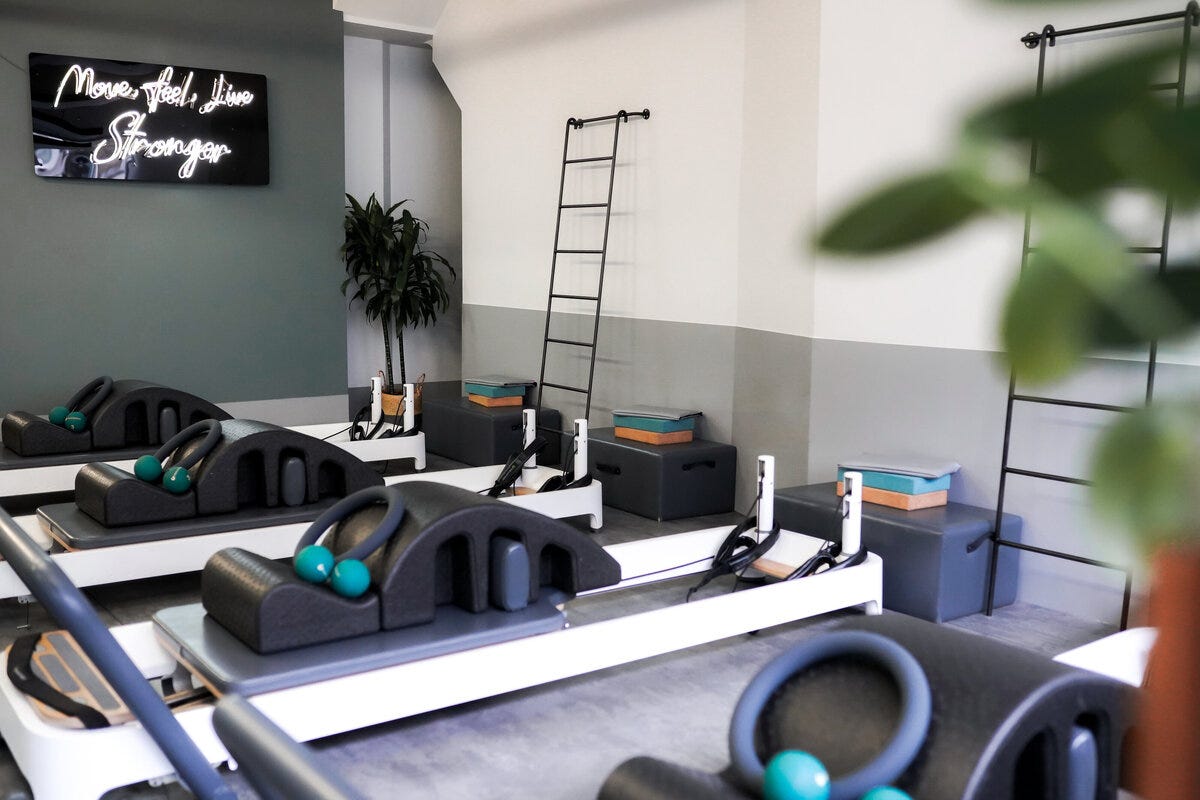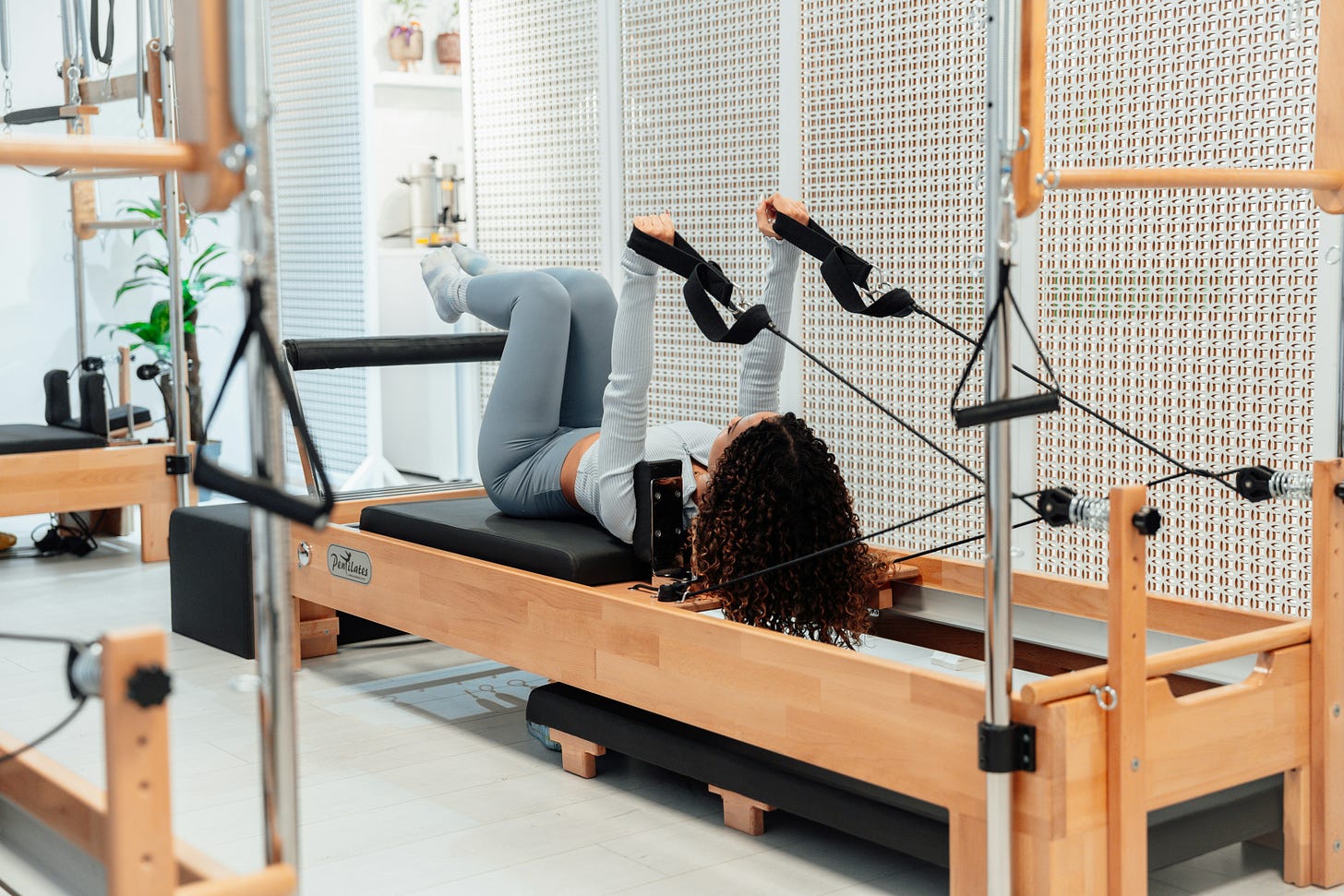The Rise of Reformer
Why is everyone suddenly obsessed with Reformer Pilates - and what’s behind the hype?
Image by Unplash
It doesn’t seem that long ago that the avocado was once deemed the most annoying food on Instagram. Specifically avocado on toast, which became a trending plate in the early 2000’s. However, nowadays it isn’t just healthy, Instagrammable toast toppings that have risen in popularity but also the way in which people choose to exercise. You might be thinking, oh no not another mention of the word RUN or the murmur of the word MARATHON - nope not those two. Alternatively, the rise of Reformer Pilates as a form of exercise has recently taken the world by storm.
Reformer Pilates, just like running is one which many people will be sick of hearing whereas others (like myself, may I add) might be curious as to why this physical activity has gained so much traction in the last couple of years. According to vice president of marketing: Ivy Wu, at popular subscription service ClassPass, Pilates has been the most-booked workout on ClassPass for two consecutive years.
However, although there is all this new talk about 5am reformer Pilates classes, followed by a protein shake and then off to work for the morning…. Pilates has actually been around for decades. So why is it so popular at the moment? Obviously social media has had a huge impact on its resurgence, contributing enormously to the universality of reformer. Platforms like Instagram and TikTok are full of fitness influencers, instructors and enthusiasts. The search term ‘pilates girls’ on TikTok has nearly 140 views - and the gliding reformer, usually found in a luxe-looking boutique gym, features in the vast majority of videos. As well as this the #pilates amasses to 2 million videos on TikTok and 30.7 million posts on Instagram.
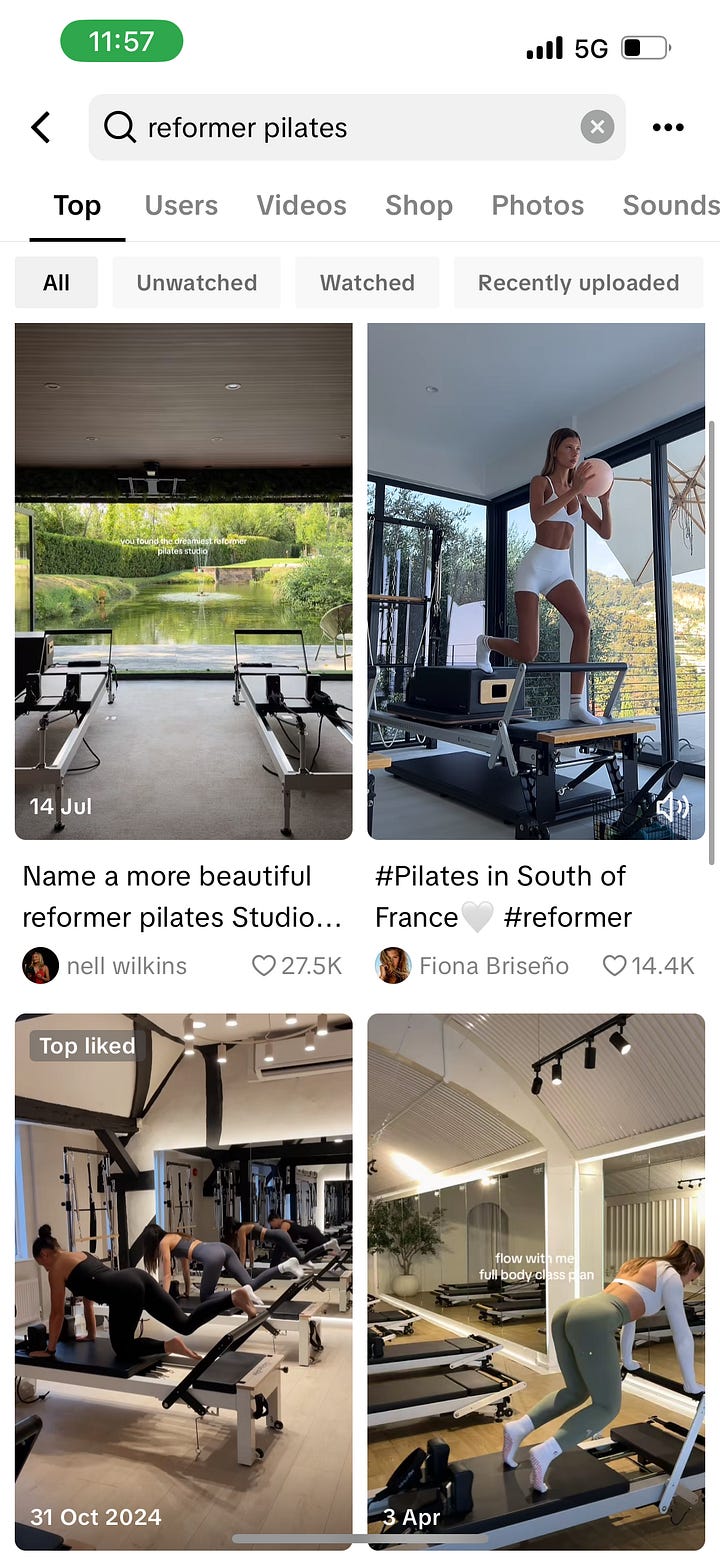
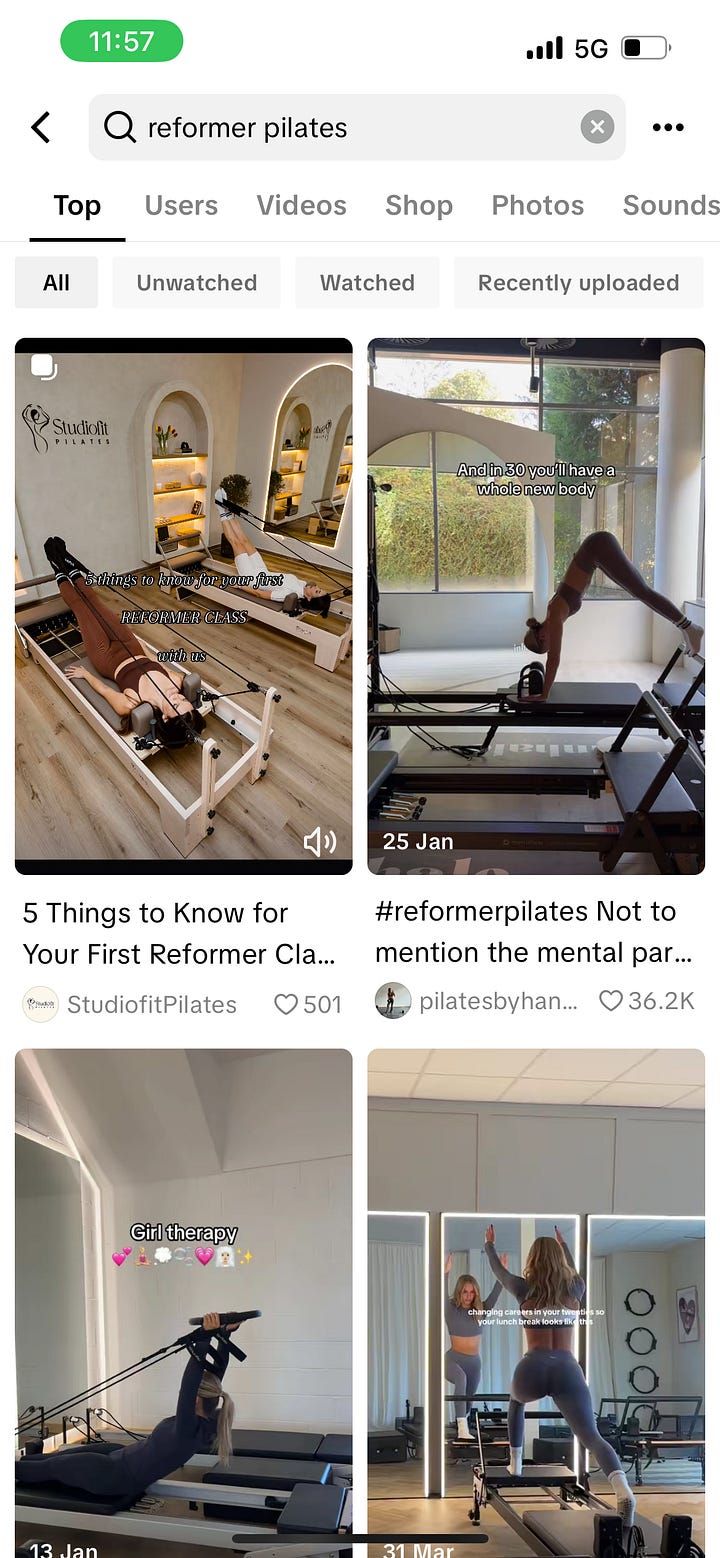
Images credit to Emily Harvey
Excluding social media, which usually plays a significant role in setting trends today, what are the other underlying factors behind reformer’s increased recognition?
To explore what’s really driving Reformer’s recent resurgence in popularity - I spoke to Megan Vickers: physiotherapist, women’s health expert, and co-founder of Four Sides London, where Reformer Pilates is central to the practice. Megan has used Reformer Pilates in her work for over 15 years and continues to integrate it into her own fitness routine. She describes its unique value as both rehab and strength-building.
Image credit to Four Sides London
“The key benefit of reformer pilates is because it works on a spring resistance, you have strengthening that happens through the range, so both in shortening the muscle and lengthening the muscle, what we call concentric and eccentric contractions. So that means it incorporates and uses the entirety of the muscle as well as creating more length within the muscle.” she explains. Ultimately, you end up with “stronger, longer muscles.”
Unlike yoga or traditional matt pilates, Reformer’s adaptability makes it ideal for injury recovery - “So because it's across gravity, it's a really great way, when someone's post operative, to get them moving again in a safe way, and it's a great way to increase the load quickly, because you've not got the added load of gravity.” Megan said that she often recommends reformer pilates to clients who are looking to regain mobility or improve their flexibility.
Why Now?
Though Reformer Pilates has been around for decades, Megan has noticed a surge in interest lately— especially in Southwest London. “We can definitely feel it on our street. There's two new reformer studios opened up just on our street in this last year. Why is that happening? Who knows? - social media, everything is a craze, and it's definitely, definitely having its heyday.” She also suggests that perhaps reformer’s exclusivity is appealing for those who are intimidated by larger class sizes - small groups and personal coaching enables more of a connection between people and therefore helps to build a community in and outside of classes.
When asked how reformer pilates compares to other modalities like yoga or strength training, Megan explained that one of reformer pilates biggest advantages is how it bridges the gap between yoga and traditional strength training “Yoga is a really great way of working on flexibility and control, but it's always within your own body weight, there is a limit in terms of strength that you can achieve.” Whereas “Reformer Pilates is work capacity. So, you get better, basically, at doing the movement, you get stronger and can do it for longer, whereas when you’re true strength training, you're building bigger muscles. So, there is a space for all three of those exercise types, because they're all focusing on different things.”
Popularity Amongst Runners
With the rise of running, Megan sees this as a key reason why reformer pilates is resonating with this community too - because more clients are using reformer to supplement their cardio training.
“Runners are getting much more savvy and educated… you can’t just run. There needs to be other things included to make sure that you're hitting your goals. If you want to run faster or run longer, it's not just a want, it's a physical capacity to be able to do that, and so you have to grow physically stronger. I think Reformer Pilates is an accessible, possibly more affordable way of people reaching strength training, much cheaper than a personal trainer, much less intimidating than an open gym space, you just have to show up. You have a coach there. They'll take you through everything you need that hopefully targets the whole body.”
While experts like Megan Vickers endorse and provide valuable insights into the benefits of Reformer Pilates from a rehab and performance aspect, personal experiences with regular participants offer a perspective that highlights its real-life appeal. Tess Harris, a regular reformer attendee who first discovered the practice through her gym, shared how her journey started with curiosity, and a little bit of intimidation.
“I think I was a bit intimidated at first because it’s a piece of equipment you don’t use for anything else,” she recalls. “But the instructor was lovely, the environment of the foundations class was really great, and so that put me at ease straight away. The more I did it, the more I enjoyed it.”
Tess also notes noticeable changes in her physique “Pilates is known for the Pilates arms” and “physically, I would say probably the biggest change is my arms are more toned. And this is actually something that my friends and my family have noticed” too. “In terms of mentally, I don't think there's been a groundbreaking change in my mentality, but I am a great believer of feeling better after doing exercise. And now that Pilates is a regular in my routine… I do feel that boost after a class.”
Like Megan, Tess emphasised how reformer fills the gap in her fitness routine, an achievable and effective way of strength training “I just think it's really good exercise for stability and strength, which sometimes can be hard to practice, because if you're not doing yoga or pilates, your stability isn't something you necessarily work on regularly.”
While Reformer Pilates often gets swept up in the clean girl aesthetic with a big stereotype being “young, 20 something, petite, girly pops” Tess finds this quite funny because personally she sees the reality a little differently: “My class is mostly actually middle-aged ladies. I don't know if that's because I go in the working day, but, yeah, I think it comes with a lot of, like, pilates, girl power, pinks and like, slick back hair, the clean girl aesthetic.” She adds “Even clothes wise, you envision a ballerina, wrap cardigans and that kind of thing. Definitely female dominated.” However, Tess emphasises that “I do have male instructors. My class is not completely female, and barely any of us look that great when we're at class, to be honest, because everyone's working out. So that kind of disrupts the clean girl aesthetic.” As well as this, she says that the portrayal of pilates on social media probably doesn’t look too hard but “I can assure you, I put in a lot of effort,” she confirms.
When asked if she follows any specific content creators or celebrities who inspired her to start reformer pilates and if so, how these have shaped her mindset or expectations Tess said there wasn’t anyone specifically who came to mind although “I do follow a few smaller reformer studios or instructors directly so friends or friends of friends who have their own Pilates classes. So, it's much more on a personal term than on a celebrity status.” However, “I do see on TikTok influencers and celebrities going to their Pilates classes, but I do think that these normally are playing into that stereotype. They're normally the clean girl aesthetic, and not necessarily 100% accurate representation.”
Image by Unsplash
Tess’s experience highlights a growing disconnect between the glossy, influencer driven image of Reformer Pilates portrayal online in comparison to her authentic, personal experience - one rooted more in genuine wellbeing and regular enjoyment of her classes, rather than aesthetic trends.
Overall, both Megan and Tess offered real-life perspectives that contrast with the hyper-polished image of Reformer Pilates often seen online.
As a physiotherapist, Megan brings a clinical, expert lens to this popular new way of exercising, explaining how reformer pilates builds strength through eccentric and concentric movement, making it ideal for rehab, long term strength training and stability. Megan emphasises that reformer pilates is probably a popular form of exercise, especially alongside the rise of running for this reason, as it bridges the gap between yoga which builds flexibility and strength training - offering the two in one.
As a regular class-goer Tess’s personal experience reinforces this point, as well as acknowledging the “clean girl aesthetic” and influencer-driven stereotypes social media provides. She values the structure, challenge and sense of community that Pilates brings to her daily life, rather than being influenced by the rise of pilates through social media.
Together, their perspectives challenge the notion that Reformer Pilates isn’t just another fleeting social media trend. Instead, they show that its appeal actually lies in tangible results, adaptability, and inclusivity - core reasons why it’s gained popularity across a large demographic of individuals, not just influencers and the pink Pilates princess stereotype.


